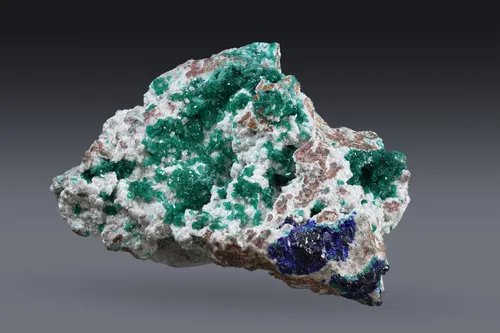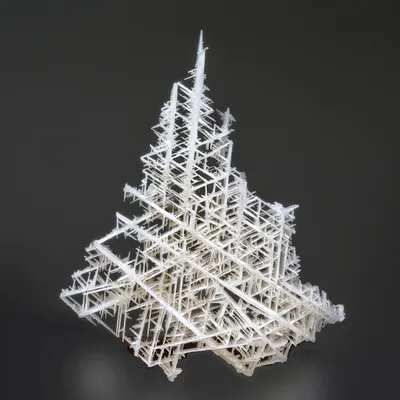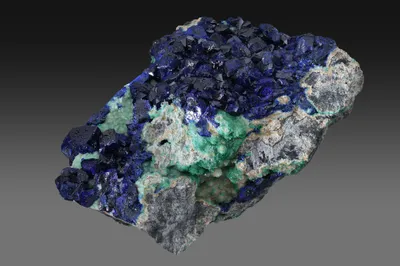
Image Credit: Malcolm Southwood
Mineral Species
Tsumebite
Type Locality
Yes
Composition
Pb2Cu(PO4)(SO4)(OH)
Crystal System
Monoclinic
Status at Tsumeb
Confirmed (type locality)
Abundance
Extremely rare
Distribution
First and second (?) oxidation zones
Paragenesis
Supergene
Entry Number
Species; TSNB357
Type Mineralogy
Tsumebite was characterised almost simultaneously by two independent workers. In July 1912, Karl Busz from the University of Münster described a new copper lead phosphate from Tsumeb and named it tsumebite (Busz 1912); just one month later, V. Rosický, at the University of Prague, described the same mineral, giving it the name "preslit" (Rosický 1912). Shortly before he published, however, Rosický’s attention was drawn to Busz’s paper. He added a note conceding that the two descriptions referred to the same mineral but adhering to his own interpretation of the symmetry (orthorhombic) which differed from that of Busz (1912) who considered it monoclinic. It was left to LaForge (1938) to resolve this issue with a detailed study of the crystal morphology, which had proven problematic for all three authors because of intergrowths and twinning. Tsumebite has grandfathered status with the IMA (http://cnmnc.units.it/; accessed January 2023). The composition of tsumebite was refined by Nichols (1966) and by Bideaux et al. (1966) with the result that the modern formula includes the sulphate anion and removes the water of crystallisation that was originally considered to be an essential component. Sadly, the type material of Busz (2012) was destroyed by WWII bombing. The specimen studied by LaForge (1938), however, is conserved at Harvard University (MGMH 101827).
General Notes
Despite its early discovery, tsumebite from the type locality remains exceptionally rare and elusive. It appears that the occurrence of tsumebite in the first oxidation zone was restricted to the upper levels. The type material, mined in (or before) 1912, must have come from above 6 Level, which was the deepest development at that time.
Tsumebite is typically well-crystallised, platy, always twinned, sometimes with multiple twinning and serrated re-entrants. Crystals are transparent, emerald-green or blue-green. Visually, tsumebite is readily confused with arsentsumebite and the vast majority of specimens labelled as "tsumebite" in private collections are, in fact, arsentsumebite. Analysis is required for certain identification.
The type paragenesis (described by Busz 1912) comprised a breccia of reddish-brown dolomite cemented by shiny white crusts of smithsonite upon which rested a few well-formed crystals of azurite. Also growing on the smithsonite were crusts of emerald-green tsumebite crystals forming intimate intergrowths. The youngest mineral in the paragenesis was cerussite, crystals of which lay on the tsumebite.
Klein (1938) stated that tsumebite was a "great rarity" found only between surface and 100 m depth (4 Level). There are five specimens listed in the Klein Collection catalogue, numbered 990 through 994 (unpublished document; Klein family archive), four of which are conserved in the collections at Harvard University. Klein attributed two of these specimens to the open pit east, two to 14 Level, and one to 6 Level. Unfortunately, however, all four of the Klein specimens available at Harvard were mis-identified by Klein. The two open pit specimens, Klein #990 (MGMH 106018) and Klein #991 (MGMH 106019) are actually zincolivenite; the specimen from 6 Level, Klein #993 (MGMH 127340) is also zincolivenite, while Klein #994 (MGMH 127341), from 14 Level, is actually malachite. To be fair to Klein, all five of these specimens are marked as questionable in his catalogue.
Pinch and Wilson (1977) described the colour of tsumebite as "light apple-green to bright emerald-green", and indicated that the first (and finest) specimens were recovered "…around 1910 at a depth of 100 m."
Two very fine examples of tsumebite, formerly in the collection of Hans von Karabacek (1878-1963) are conserved at Harvard University (MGMH 101827 and 101828) and, as noted above, MGMH 101827 was the source of the crystals measured by LaForge (1938).
A specimen of tsumebite (analysed) in the collection of Museum Victoria, Australia, (catalogue number 53155) originally from the collection of Tsumeb Corporation mineralogist John Innes, exhibits a different habit and paragenesis; earthy pistachio-green tsumebite is associated with philipsbornite (XRD confirmed). This specimen requires further study, and there is a possibility that it has a second oxidation zone origin.
Tabular crystals of blue-green tsumebite (EDS and Raman verified) have been reported by Joy Désor (2020) from an unusual phosphate paragenesis in vugs hosted by germanite-rich sulphide ore, almost certainly of second oxidation zone origin (https://www.mindat.org/photo-1036642.html; accessed October 2022). Crystals of tsumebite (to c. 40 µm) are associated with pale olive-green needles of libethenite. Corkite, plumbogummite and pyromorphite are also associated.
Associated Minerals
azurite; bayldonite; cerussite; corkite; dolomite; germanite; libethenite; malachite; philipsbornite; plumbogummite; pyromorphite; quartz; smithsonite
Pseudomorphs
Tsumebite is reported to form pseudomorphs after the following minerals: mimetite (rare, doubtful status); pyromorphite (rare, doubtful status).





